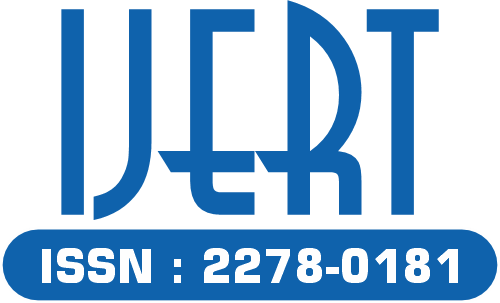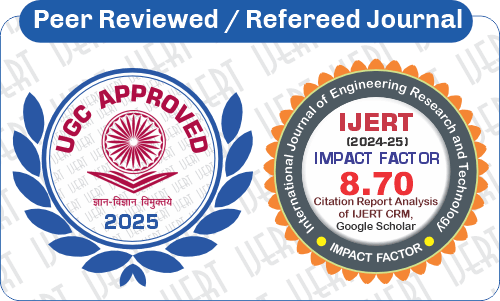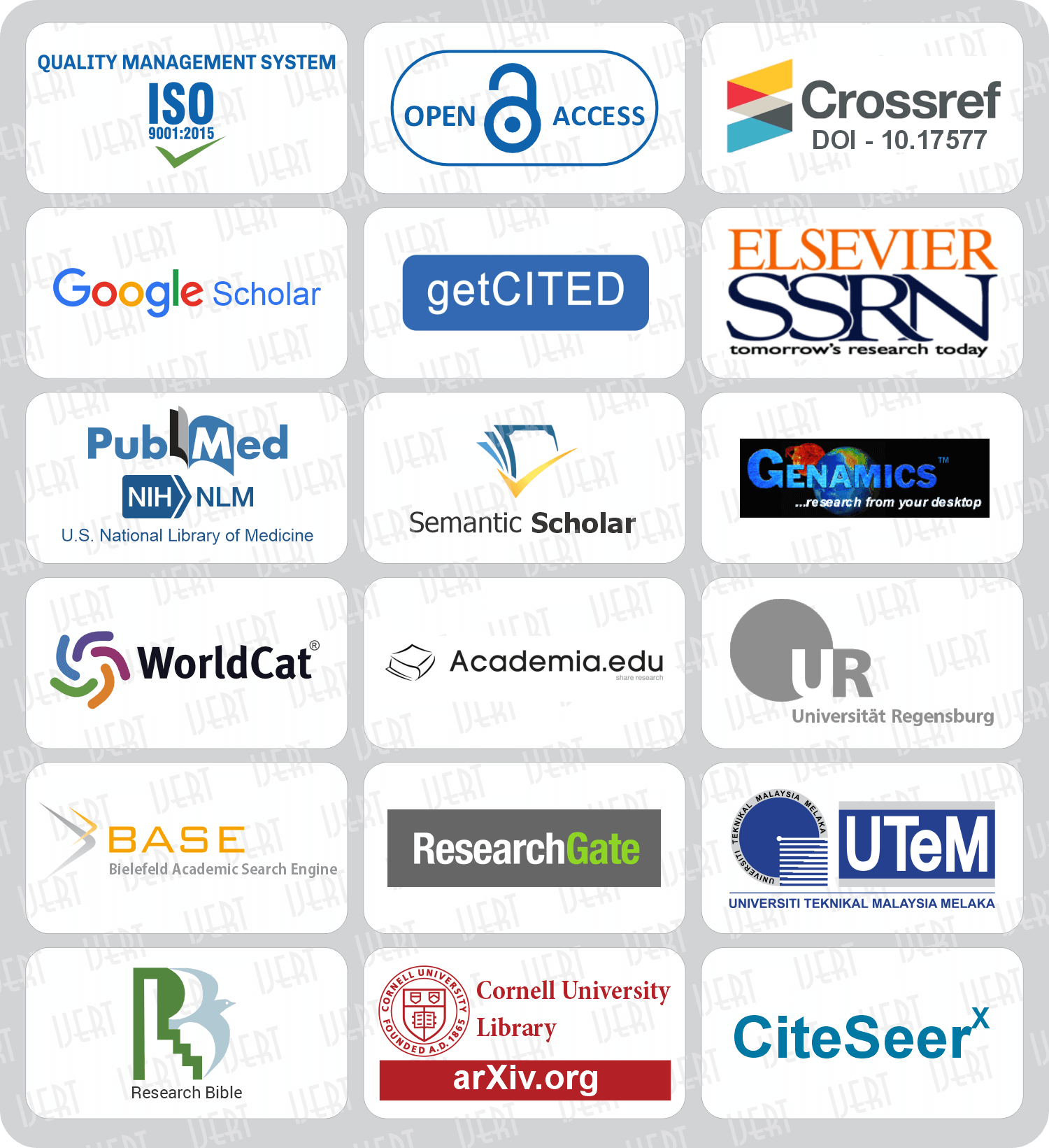 DOI : 10.17577/IJERTV14IS020071
DOI : 10.17577/IJERTV14IS020071

- Open Access

- Authors : Dr.P.Jamuna Devi, Dr.K.Arul Marie Joycee, Dr.R.Sophia Porchelvi, Dr.G.Sudha, Dr.R.Karthi, Dr.R.Vanitha
- Paper ID : IJERTV14IS020071
- Volume & Issue : Volume 14, Issue 2 (February 2025)
- Published (First Online): 04-03-2025
- ISSN (Online) : 2278-0181
- Publisher Name : IJERT
- License:
 This work is licensed under a Creative Commons Attribution 4.0 International License
This work is licensed under a Creative Commons Attribution 4.0 International License
Transportation Problem in Evaluating the Efficiency of Transport Hubs with Special Reference to Tamilnadu
Dr.P.Jamuna Devi
Assistant Professor of Mathematics, PG& Research Department of Mathematics
A.D.M College for Women (Autonomous) Nagapattinam. Affiliated to Bharathidasan University, Tiruchirapalli,
Tamilnadu, India.
Dr.R.Sophia Porchelvi
Associate Professor of Mathematics PG& Research Department of Mathematics
A.D.M College for Women (Autonomous) Nagapattinam. Affiliated to Bharathidasan University, Tiruchirapalli,
Tamilnadu, India.
Dr.R.Karthi
Professor, Department of Management Studies,
E.G.S. Pillay Engineering College, Nagapattinam. Affiliated to Anna University, Chennai. Tamilnadu, India.
Dr.K.Arul Marie Joycee
Assistant Professor of Computer Science
A.D.M College for Women (Autonomous) Nagapattinam. Affiliated to Bharathidasan University, Tiruchirapalli,
Tamilnadu, India.
Dr.G.Sudha
Assistant Professor of Mathematics, PG& Research Department of Mathematics
A.D.M College for Women (Autonomous) Nagapattinam. Affiliated to Bharathidasan University, Tiruchirapalli,
Tamilnadu, India.
Dr.R.Vanitha
Associate Professor of Mathematics, PG& Research Department of Mathematics
A.D.M College for Women (Autonomous) Nagapattinam. Affiliated to Bharathidasan University, Tiruchirapalli,
Tamilnadu, India.
Abstract: Bus terminals and train stations are examples of transportation hubs that are essential to providing passengers with easy access and connectivity. The effectiveness of transportation hubs has a direct impact on the expansion of tourism and economic development in Tamil Nadu, a state with a rich cultural legacy and a high volume of both local and foreign visitors. However, issues like traffic, bad infrastructure, ineffective last-mile connectivity, and inefficient services make it difficult to have the best possible mobility experiences. This study looks at how Tamil Nadu's transportation issues impact the effectiveness of its transportation hubs. It assesses important elements such traveler happiness, infrastructure sufficiency, operational capacity, passenger flow management, and accessibility. The study finds significant inefficiencies and makes strategic recommendations for improving the transport hub using a combination of statistical analysis, field observations, and stakeholder questionnaires.
Keywords: Transports hub – Transportation problem – computational procedure – passenger flow solution
I INTRODUCTION
Particularly in regions like Tamil Nadu, which are well-known for their natural attractions, pilgrimage sites, and cultural legacy, transportation is essential to the growth of tourism and economic expansion. For both local and foreign tourists, smooth mobility depends on having efficient transportation hubs, such as bus terminals and train stations. However, transportation inefficiencies continue to exist despite ongoing advancements in connection and infrastructure, which affects accessibility and travel experiences in general.
Being one of the most visited states in India, Tamil Nadu mostly depends on its transportation hubs to make travel easier for visitors. While bus and rail networks provide access to more rural and isolated locations, major towns like Chennai, Madurai, Coimbatore, and Trichy are essential transit hubs. However, issues such as congestion, inadequate passenger facilities, poor last-mile connectivity, and infrastructural constraints pose significant challenges. Understanding and evaluating these transportation problems is essential for
enhancing efficiency, improving service quality, and promoting sustainable tourism.
This study aims to assess the transportation challenges in evaluating the efficiency of transport hubs in Tamil Nadu, with a focus on factors such as operational capacity, infrastructure adequacy, accessibility, and traveler satisfaction. Through a detailed analysis of key transport hubs, this research will provide insights into existing inefficiencies and propose recommendations for optimizing transport services to support tourism growth and economic development.
II REVIEW OF LITERATURE
Numerous studies have looked at transportation issues and how they affect economic growth, infrastructural development, and mobility. By guaranteeing smooth connectivity between locations, an effective transportation network boosts tourism growth, claim [1] Rodrigue et al. (2020). The quality of transportation infrastructure has a direct impact on the travel experience, affecting visitor satisfaction and return visits, according to studies by Page [1]. In their evaluation of Indian railway stations, Jain & Tiwari (2018) discovered that inadequate last-mile connection, overcrowding, and a lack of amenities all drastically lower efficiency. Similar to this, Sharma & Singh [3] examined bus terminals and identified issues that result in commuter discontent, including inadequate maintenance, ineffective scheduling, and a lack of real-time information systems.
Regional hubs suffer from poor intermodal connection and insufficient passenger facilities, whereas major transport hubs in cities like Chennai and Madurai are well-equipped, according to studies conducted by Ramachandran [4] on urban mobility in Tamil Nadu. Additionally, in order to increase efficiency and enhance the customer experience, a report published in 2021 by the Tamil Nadu State Transport Department emphasized the necessity of modernizing railway stations and bus terminals. Poor transportation infrastructure has a detrimental effect on tourism and economic growth in cultural areas, according to a study by Das & Bose [6]. Seasonal overpopulation in Tamil Nadu causes lengthy wait times and inconvenience for visitors to places like Kanyakumari and Rameswaram.
Studies by Iyer & Rao [7] indicate that smart transport solutions, such as digital ticketing, real-time monitoring, and integrated transport planning, can significantly enhance efficiency in tourist-centric transport hubs. According to Banerjee et al. [8], the adoption of smart mobility solutions, such as electric buses, metro expansions, and smart traffic management systems, can enhance transport hub efficiency. In Tamil Nadu, government initiatives like metro rail expansion in Chennai and the Smart City Mission aim to improve urban mobility and reduce congestion at key transport hubs. Statistical models have been studied in case of employee transport [10].
Regression models for people working in Fire work industry
[11] and studies on semi urban areas [12] are reviewed. According to [13] transport facility is the major challengefaced by tourists in Nagapattinam region. Other studies at Nagapattinam region are stated in [14]. Application of ternary equations in real time problem is discussed by the author in [15]. Transport satisfaction provided to customer is statistically analyzed in [16]. Another study of problems faced by Tourist is analyzed mathematically in [17]. Many reviews have been done on interest in the Transportation problem [18]. Mathematical Models like Group decision making in deciding the transportation in safe disposal of commercial fish waste is studied by [19]. Interval Transportation problem is solved to minimize transportation cost [20]. Mathematical Modeling the transshipment problem in the Solid Waste Management of a town is recorded in [21]. Other solution models are examined by [22].
III PROBLEM IDENTIFICATION
When assessing the effectiveness of Tamil Nadu's transportation hubs, the following major issues were found. Due to heavy passenger volumes, major transportation hubs in Tamil Nadu are too congested, especially during holidays and busy seasons. Many bus and train services in Tamil Nadu operate without real-time scheduling and tracking systems, leading to long waiting times and uncertainty for passengers.
IV MATHEMATICAL TRANSPORTATION PROBLEM AND SOLUTION
Finding the most economical method to move items from several sources (origins) to several destinations while meeting supply and demand restrictions is the focus of the Transportation Problem, a subset of the Linear Programming Problem (LPP). Logistics, supply chain management, and transportation network optimization all make extensive use of it.
Problem Statement:
Consider a transportation network in Tamil Nadu where three major bus depots (Departure point) need to transport a certain number of buses to three tourist cities (arrival point). The goal is to minimize transportation costs while ensuring that the constraints are met.
Given Data:
-
Departure points (DP): Chennai, Coimbatore, Madurai
-
Arrival Points (AP)): Kanyakumari, Rameswaram, Ooty
-
Transportation Costs (in INR per bus)
Table 1: Initial table
|
Kanyakumari |
Rameswaram |
Ooty |
Supply |
|
|
Chennai |
10 |
12 |
15 |
50 |
|
Coimbatore |
8 |
10 |
12 |
60 |
|
Madurai |
9 |
7 |
10 |
40 |
|
30 |
50 |
70 |
The objective is to determine the optimal number of buses transported from each depot to each city to minimize the total cost.
Mathematical Formulation
-
Decision Variables
Let xij represent the number of buses transported from depot i to city j.
(Buses needed at Kanyakumari) x12+x22+x32=50
(Buses needed at Rameswaram) x13+x23+x33=70
(Buses needed at Ooty)
Non-Negativity Constraint:
xij0, meaning the number of buses transported must be non-negative.
Table 2: NWCR : Step 1: Initial Allocation
Kanya kumari
Rameswa ram
Ooty
Supply
Chennai (50)
30
20
0
50
Coimbatore(60)
0
30
30
60
Madurai(40)
0
0
40
40
Demand
30
50
70
1.
-
Objective Function (Minimize Cost)
Z=10×11+ 12×12+ 15×13 + 8×21+ 10×22+ 12×23+
9×31+ 7×32 + 10×33
The goal is to minimize Z, the total transportation cost.
-
Constraints
Supply Constraints:
x11+x12+x13=50
(Buses available at Chennai) x21+x22+x23= 60
(Buses available at Coimbatore) x31+x32+x33=40
(Buses available at Madurai)
Demand Constraints: x11+x21+x31=30
Step 2: Compute Total Cost
Z = (30×10)+(20×12)+(30×10)+(30×12)+(40×10)
=300+240+300+360+400 = 1600
Thus, the initial feasible transportation cost is 1600. Further optimization methods like the Modified Distribution (MODI) Method can be used to find the optimal solution, reducing costs further.
C Programming:
#include <stdio.h> #define DEPOTS 3
#define CITIES 3
// Cost matrix
int cost[DEPOTS][CITIES] = {
{10, 12, 15},
{8, 10, 12},
{9, 7, 10}
};
// Supply at each depot
int supply[DEPOTS] = {50, 60, 40};
// Demand at each city
int demand[CITIES] = {30, 50, 70};
// Transportation matrix
int allocation[DEPOTS][CITIES] = {0};
Published by :
// Function to solve the transportation problem using a simple heuristic approach
void solveTransportationProblem() { int i = 0, j = 0;
while (i < DEPOTS && j < CITIES) {
int allocated = (supply[i] < demand[j]) ? supply[i] : demand[j];
allocation[i][j] = allocated; supply[i] -= allocated; demand[j] -= allocated;
if (supply[i] == 0) i++; // Move to next depot if (demand[j] == 0) j++; // Move to next city
}
}
// Function to calculate total cost int calculateTotalCost() {
int totalCost = 0;
for (int i = 0; i < DEPOTS; i++) { for (int j = 0; j < CITIES; j++) {
totalCost += allocation[i][j] * cost[i][j];
}
}
return totalCost;
}
// Function to print the allocation matrix void printSolution() {
printf("Optimal Transportation Plan:\n"); for (int i = 0; i < DEPOTS; i++) {
for (int j = 0; j < CITIES; j++) { printf("%d\t", allocation[i][j]);
}
printf("\n");
}
printf("Total Minimum Cost: %d\n", calculateTotalCost());
}
int main() { solveTransportationProblem(); printSolution();
return 0;
}
CONCLUSION
This transportation problem effectively demonstrates how to minimize costs while distributing buses efficiently from supply points (depots) to demand points (cities). Using optimization techniques, transportation planners in Tamil Nadu can improve transport hub efficiency and optimize resource allocation for better connectivity and tourism growth.
International Journal of Engineering Research & Technology (IJERT)
ISSN: 2278-0181
Vol. 14 Issue 02, February-2025
REFERENCES
-
Rodrigue, J. P., Comtois, C., & Slack, B. (2020). The Geography of Transport Systems (5th ed.). Routledge.Page, S. J. (2019). Transport and Tourism: Global Perspectives (4th ed.). Routledge.
-
Jain, A., & Tiwari, G. (2018). "Assessing the Efficiency of Railway Stations in India: A Case Study." Journal of Transport Economics and Policy, 52(3), 345-365.
-
Sharma, R., & Singh, P. (2021). "Evaluating the Role of Bus Terminals in Urban Transport Networks." International Journal of Transportation Studies, 9(2), 115-130.
-
Ramachandran, K. (2017). Urban Mobility Challenges in Tamil Nadu: A Policy Perspective. Indian Institute of Planning and Management.
-
Tamil Nadu State Transport Department. (2021). Annual Report on Public Transportation and Infrastructure Development. Government of Tamil Nadu.
-
Das, S., & Bose, A. (2020). "Tourism and Transportation Infrastructure: Analyzing the Impact in Indian Heritage Cities." Journal of Sustainable Tourism, 28(4), 567-583.
-
Iyer, M., & Rao, S. (2022). "Smart Transport Solutions for Sustainable Tourism Development." International Journal of Smart Mobility, 5(1), 23-41.
-
Banerjee, A., Mehta, P., & Sinha, V. (2023). "Sustainable Urban Transport Systems: Case Studies from Indian Smart Cities." Journal of Urban Development, 15(3), 200-218.
-
Hillier, F. S., & Lieberman, G. J. (2021). Introduction to Operations Research (11th ed.). McGraw-Hill.
-
Karthi, R., and P. Jamuna Devi. "A study on employee retention in leading multinational automobile sector in India." International Journal of Management Research and Reviews 2.9 (2012): 1474. https://www.proquest.com/openvew/16ff291882b0bb00485b847be 7d86c34/1?pq-origsite=gscholar&cbl=2028922
-
Porchelvi, R. Sophia, and P. Jamuna Devi. "Regression model for the people working in fire work industry-Virudhunagar district." Int J Sci Res Publ 5 (2015): 1-6. https://citeseerx.ist.psu.edu/document?repid=rep1&type=pdf&doi=b 8ac005959bdd68317f55df804e643ed30d915db
-
Karthi, R., and P. Jamuna Devi. "Effectiveness Of Online Teaching And Learning Process In Semi Urban Areas-An Empirical Statistical Study." The Online Journal of Distance Education and e- Learning 9.2 (2021): 1-4. https://www.tojsat.net/journals/tojdel/articles/v09i02/v09i02-06.pdf
-
Karthi, R., P. Jamuna Devi, and B. Asha Daisy. "Challenges Faced by Tourist in Nagapattinam District: A Statistical Analysis." International Journal of Hospitality and Tourism Systems 5.2 (2012):
https://www.proquest.com/openview/98ad7be126838b0300fa5e39e 2ea9f03/1?pq-origsite=gscholar&cbl=2030938
-
Karthi, R., M. Selvachandra, and P. JamunaDevi. "Perspective of insurance agents' about LIC of India-A study at Nagapattinam District." IEEE-International Conference On Advances In Engineering, Science And Management (ICAESM-2012). IEEE, 2012. https://ieeexplore.ieee.org/abstract/document/6216224
-
Devi, P. Jamuna, and K. S. Araththi. "On the Ternary Cubic Diophantine." Technology 17.33 (2024): 3473-3480. https://sciresol.s3.us-east- 2.amazonaws.com/IJST/Articles/2024/Issue-33/IJST-2024-2186.pdf
-
Karthi, R., P. Jamuna Devi, and G. Midhunalakshmi. "Customer Relationship and Marketing of Banking Services through Internet in India." Indian Journal of Arts 6.18 (2016):69-75. https://www.indianjournals.com/ijor.aspx?target=ijor:ija3&volume= 6&issue=18&article=001
-
Karthi, R., P. Jamuna Devi, and R. Sophia Porchelvi. "Problems faced by tourist in Nagapattinam District-A statistical analysis." IEEE-International Conference On Advances In Engineering, Science And Management (ICAESM-2012). IEEE, 2012. https://ieeexplore.ieee.org/abstract/document/6216223
-
Devi, P. Jamuna, R. Padmasri, and D. Bindhu. "Review on transportation scheduling problem." Indian Journal of Arts 6.19 (2016): 117-121.
https://www.indianjournals.com/ijor.aspx?target=ijor:ija3&volume= 6&issue=19&article=004
Published by : http://www.ijert.org
International Journal of Engineering Research & Technology (IJERT)
ISSN: 2278-0181
Vol. 14 Issue 02, February-2025
-
Porchelvi, R. Sophia, and P. Jamuna Devi. "Group Decision Making For Safe Disposal of Commercial Fish Waste.", IJSRP International Journal of scientific and Research Publications, Volume 5, Issue 4, April, ISSN 2250 3153, page 1-6, 2015
https://citeseerx.ist.psu.edu/document?repid=rep1&type=pdf&doi=9 3264441d49e05985e47d7598b8651a7bcc64fb1
-
Porchelvi, R. Sophia, and P. Jamuna Devi. "Biomass for Energy Production and Interval Transportation Problem to Minimize Transportation Cost." Population 46155.46933: 93148. http://49.50.81.200/iosr-jbm/papers/NCCMPCW/P005.pdf
-
Porchelvi, R. Sophia, and P. Jamuna Devi. "Modelling and Optimising the Transhipment Problem of Nagapattinam Municipality Solid Waste Management.", International Journal of Engineering Research, Vol 2, Issue -8, Oct, 117-130, ISSN 2321-
1717
https://d1wqtxts1xzle7.cloudfront.net/82105409/download- libre.pdf?1647199339=&response-content- disposition=inline%3B+filename%3DModelling_and_Optimising_ the_Transhipmen.pdf&Expires=1740122488&Signature=MIfnieVhr f5merk2Mmt3CB~tjutsATWufU3GiMHm-qLxzD6I
-
KSA P. Jamuna Devi, On Solving Cubic Equation x^3+y^3 =7(z- w)^2 (z+w), Advances in Nonlinear Variational Inequalities, Volume 27, issue 2, pages, 328-332, ISSN: 1092-910X, 2024, https://doi.org/10.52783/anvi.v27.969




